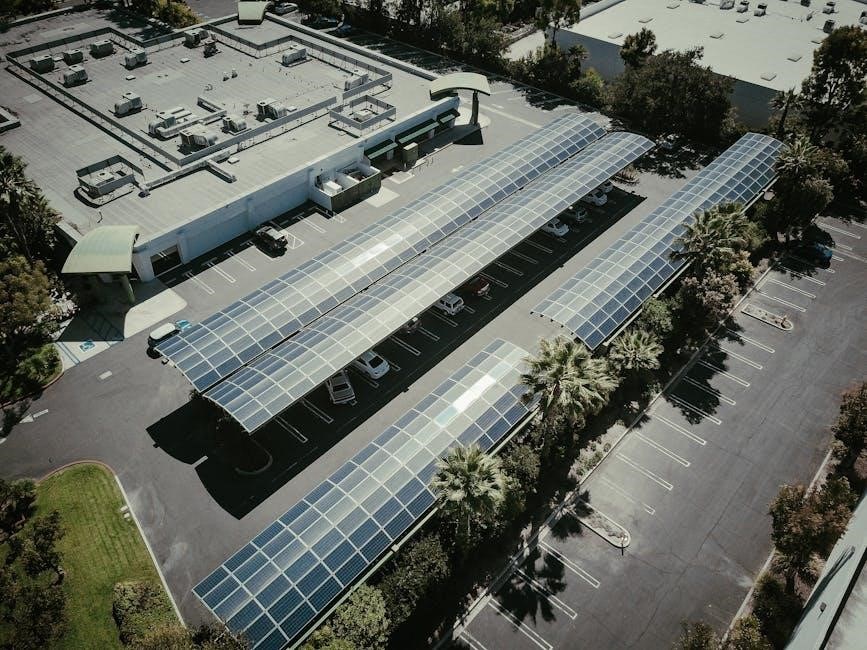- Home
- Instructions
- carport installation instructions

carport installation instructions
A carport is a structure offering shelter for vehicles‚ typically open-sided. It protects cars from weather and enhances property value. This guide provides step-by-step instructions for installation.
1.1. What is a Carport?
A carport is an open or partially enclosed structure designed to provide shelter for vehicles. Unlike a garage‚ it typically has open sides and a roof‚ offering protection from weather conditions such as rain‚ sun‚ and snow. Carports can be constructed from various materials‚ including metal‚ wood‚ or fabric‚ and are available in different sizes to accommodate one or multiple vehicles. They are often preferred for their simplicity‚ cost-effectiveness‚ and ease of installation compared to traditional garages. Additionally‚ carports can serve as versatile spaces‚ offering storage options or shaded areas for outdoor activities‚ and may enhance a property’s curb appeal and value.
1.2. Benefits of Installing a Carport
Installing a carport offers numerous advantages‚ including enhanced security and aesthetic appeal. It provides shade and protection from harsh weather‚ reducing vehicle maintenance. Carports can boost property value and serve as versatile outdoor spaces. They are cost-effective and easier to install compared to garages. Additionally‚ carports require low maintenance and can be customized to match your home’s style. They also offer storage options and may provide insurance benefits‚ making them a practical and beneficial addition to any property.
Planning and Preparation
Assess the site‚ obtain permits‚ and gather materials. Ensure compliance with local codes and measure carefully to avoid costly mistakes during installation.
2.1. Choosing the Right Location
Selecting the ideal spot for your carport is crucial. Ensure it is close to your house for convenience but far enough to avoid obstructing windows or doors. Consider drainage to prevent water pooling. Choose a flat area to simplify construction‚ or opt for slight elevation if drainage is a concern. Measure your vehicle to determine the necessary space‚ ensuring the carport is large enough to accommodate it comfortably. Also‚ verify local building codes and property lines to avoid legal issues. Proper planning ensures functionality and compliance.
2.2. Obtaining Necessary Permits
Before starting your carport installation‚ ensure you obtain all required permits. Check local building codes and zoning regulations to determine if a permit is needed. Submit detailed plans‚ including dimensions and materials‚ for approval. A building inspector may visit to verify compliance. Failure to secure permits can result in fines or project halts. Research early to avoid delays and ensure your carport meets legal standards.
2.3. Gathering Materials and Tools
To ensure a smooth installation process‚ gather all necessary materials and tools in advance. Common materials include lumber (2x4s‚ 2x6s)‚ roofing materials (metal‚ asphalt shingles)‚ concrete for footings‚ and fasteners (screws‚ nails‚ bolts). Tools required include a tape measure‚ level‚ wrench‚ drill‚ impact driver‚ circular saw‚ ladder‚ and safety gear like gloves and goggles. Additional items like flashing‚ weatherproofing sealants‚ and a wheelbarrow for mixing concrete are also essential. Organize these items to avoid delays during construction.

Site Preparation
Clear the land of debris and vegetation. Ensure the ground is level and compact for a stable base‚ essential for proper carport construction and safety.
3.1. Clearing the Land
Before installation‚ ensure the site is clear of debris‚ vegetation‚ and obstructions. Mark the area with stakes and twine to define the workspace. Remove trees‚ shrubs‚ or rocks that may interfere with construction. Check for underground utilities like water‚ gas‚ or electric lines to avoid damage. Use tools like shovels or chainsaws for clearing. Level the ground slightly to ensure even placement of the carport foundation. Professional assistance may be needed for complex terrain or large obstacles.
3.2. Leveling the Ground
Leveling the ground ensures a stable base for your carport. Start by clearing debris and marking the area with stakes. Use a shovel or excavator to dig slightly uneven spots; Compact the soil with a hand tamper or plate compactor. Check the surface with a spirit level; repeat until the ground is even. Proper leveling prevents structural issues and ensures proper water drainage. Finish by laying a gravel base for added stability and drainage.

Anchoring the Carport
Ensuring a stable base is crucial for carport durability. Anchors provide structural integrity‚ preventing movement or collapse. Use high-quality materials and follow manufacturer instructions for secure installation.
4.1. Types of Anchors
Carport anchors ensure stability and safety. Common types include concrete anchors‚ ground screws‚ and mobile home anchors. Concrete anchors are durable and suitable for permanent installations‚ while ground screws offer easy installation and adjustability. Mobile home anchors are designed for temporary or portable carports. Each type provides secure fastening‚ protecting the structure from harsh weather conditions and ensuring long-term durability. Proper anchor selection is crucial for the carport’s stability and safety.
4.2. Installing Anchors
Installing anchors securely fastens your carport to the ground. Start by marking anchor locations‚ ensuring they align with the carport’s base. For concrete‚ use anchor bolts‚ drilling holes and setting them in place. For ground‚ screw-in or hammer-in anchors work best. Tighten all bolts firmly‚ ensuring stability. Use a spirit level to confirm proper alignment. Regularly inspect and tighten anchors to maintain structural integrity. Proper installation ensures safety and prevents damage from wind or shifting soil. Follow manufacturer instructions for specific anchor types and torque requirements.

Assembling the Frame
Construct the base‚ attach columns‚ and secure beams. Ensure all connections are tight and aligned. Use appropriate tools for precise assembly and safety.
5.1. Constructing the Base
Constructing the base involves preparing the site and laying the foundation. Begin by marking the area and digging shallow trenches for footings. Pour concrete into the trenches‚ ensuring it’s level and evenly spread. Allow the concrete to cure completely before proceeding. Next‚ set the foundation posts or pillars into the footings‚ securing them with anchor bolts. Use a level to ensure they are perfectly vertical. This step provides the structural support for the entire carport‚ so precision is crucial. Properly anchoring the base ensures stability and safety.
5.2. Attaching the Columns
Ensure the base is level and secure before attaching columns. Use anchor bolts to fasten columns to concrete footings for stability. Check manufacturer instructions for material-specific guidance. Maintain proper column spacing for structural integrity and aesthetics. Align columns vertically using tools like a plumb line or laser level. Secure columns with appropriate fasteners‚ such as bolts or lag screws‚ depending on material. Tighten all connections properly and consider consulting a professional to meet local building codes. Regularly inspect and tighten fasteners post-installation for long-term stability.
5.3. Securing the Beams
After assembling the frame‚ focus on securing the beams to ensure structural stability. Use high-strength bolts or screws to attach beams to columns and base. Tighten firmly.
Ensure beams are level and evenly spaced. Double-check alignment and tighten all connections. Properly secured beams provide a solid foundation for the roof and overall carport stability.

Installing the Roof
Attach roof panels securely to the frame‚ ensuring proper alignment. Use weatherproof materials and fasteners to create a durable‚ weather-tight seal for long-lasting protection.
6.1. Roofing Material Options
When installing a carport roof‚ choose materials that suit your needs. Popular options include metal roofing for durability‚ asphalt shingles for affordability‚ and corrugated iron for a rustic look. Polycarbonate or PVC sheets offer lightweight‚ weather-resistant solutions. Each material has unique benefits‚ such as metal’s low maintenance or polycarbonate’s translucency for natural light. Consider factors like climate‚ budget‚ and desired aesthetics to select the best roofing material for your carport.
6.2. Mounting the Roof Panels
Begin by preparing the frame to ensure it is level and secure. Align the roof panels according to the manufacturer’s instructions‚ starting from the front edge. Use the provided hardware to attach panels to the frame‚ ensuring a snug fit. Tighten all screws firmly but avoid over-tightening. Check alignment as you progress to maintain even spacing. Once all panels are in place‚ secure them with additional fasteners if needed. Finally‚ seal any gaps to ensure water tightness and durability.
6.3. Securing the Roof
Securing the roof is critical for stability and durability. Start by ensuring all panels are tightly fastened using the provided hardware. Weatherproof seals should be applied to prevent leaks; Inspect the frame for alignment and tighten any loose connections. Finally‚ test the roof’s integrity by applying gentle pressure to confirm it can withstand wind and weight loads. Proper securing ensures safety and extends the structure’s lifespan.
- Tighten all bolts and screws thoroughly.
- Apply weatherproofing to seams and edges.
- Double-check frame alignment for even support.

Attaching Walls and Doors
Attach walls by constructing a frame with appropriate lumber and securing it to the carport using screws or bolts. For doors‚ install a door frame‚ attach hinges‚ and ensure proper alignment. Use a spirit level to maintain evenness‚ and secure doors with latches or locks. Consider adding siding for weather protection. Gather necessary tools like drills‚ screwdrivers‚ and saws. Plan carefully‚ check local regulations‚ and consider seeking assistance for accuracy and efficiency. Allow sufficient time for the process‚ and explore pre-made kits or tutorials for guidance. Ensure all elements are secure and level for a durable and functional result.
7.1. Adding Side Walls
Adding side walls to your carport provides additional protection from wind and weather; Use materials like wood or metal‚ ensuring they match the carport’s design. Properly align the walls with the frame and secure them with bolts or screws. Ensure the walls are plumb and the structure remains stable. You can customize the walls with windows or doors for extra functionality. Always follow local building codes and seal any gaps to maintain durability and weather resistance.
7.2. Installing Doors
Installing doors on your carport involves selecting the right type‚ such as swing or sliding doors‚ and ensuring proper alignment. Use hinges and a latch for secure closure.
Measure the doorway to confirm the door fits perfectly. Attach hinges to the door frame and install a latch for easy opening and closing. Add weatherproofing seals for protection.

Finishing Touches
Trim excess materials‚ seal gaps‚ and apply protective coatings. Paint or stain for aesthetics. Ensure all components are secure and visually inspect for completeness and safety.
8.1. Trimming and Sealing
Trimming and sealing are essential for a polished finish. Use sharp tools to cut excess roofing material or flashing. Apply weatherproof sealant to gaps and joints‚ ensuring no water seeps through. Smooth out any rough edges to prevent damage or injury. Inspect the structure thoroughly to ensure all seals are secure and even. Proper sealing prevents leaks and extends the carport’s lifespan.
8.2. Painting or Coating
Painting or coating your carport enhances durability and aesthetics. Use weather-resistant paints or galvanized coatings for metal structures. Clean the surface thoroughly‚ sand if necessary‚ and apply a primer for better adhesion. Choose colors that match your property for a cohesive look. For metal carports‚ consider rust-proof coatings to extend lifespan. Apply paint or coatings evenly‚ following manufacturer instructions. Allow proper drying time before exposing the carport to weather conditions. Regular touch-ups can maintain its appearance and protect against damage.

Inspection and Testing
Inspect the carport for stability‚ ensuring all bolts are tightened and the structure is level. Check for roof leaks and verify all components are securely fastened. Conduct a final safety inspection to ensure everything is in proper condition.
9.1. Checking Stability
Stability is crucial for a carport’s safety and durability. Begin by visually inspecting the structure for any signs of damage or unevenness. Use a spirit level to ensure all beams and columns are perfectly aligned. Gently shake the structure to test for movement. If it feels unstable‚ check the anchors and tightening all bolts. Ensure the foundation is secure and level. Regular inspections can prevent potential issues. Consider hiring a professional for older carports to verify stability and safety standards.
9.2. Ensuring Water Tightness
Ensuring water tightness is crucial for carport durability. Inspect roofing materials for cracks or gaps. Apply waterproof sealants to joints and seams. Use durable‚ weather-resistant roofing options like metal or asphalt. Secure roofing panels tightly to prevent leaks. Check drainage systems to avoid water pooling. Regularly inspect and maintain the roof to address potential issues early. A watertight carport protects vehicles and extends its lifespan‚ ensuring long-term functionality and structural integrity.

Maintenance and Repair
Regular maintenance ensures longevity. Inspect for rust‚ clean debris‚ and tighten loose parts. Addressing minor issues early prevents costly repairs.
Common repairs include replacing damaged panels or securing unstable frames. Regular checks and timely fixes keep your carport safe and functional for years.
10.1. Regular Maintenance Tips
Regular maintenance ensures your carport remains durable and functional. Clean debris from the roof and gutters to prevent water accumulation. Inspect for loose screws‚ dents‚ or rust‚ and address them promptly. Apply protective coatings to metal parts to prevent corrosion. Trim nearby plants to avoid damage from overgrown branches. Check roofing materials for cracks or gaps and seal them. Schedule annual inspections by professionals to identify potential issues early. Replace worn-out components to maintain structural integrity and safety.
10.2. Common Repairs
Common carport repairs include fixing roof leaks‚ replacing rusty frames‚ and tightening loose bolts. Regular inspections can prevent major issues. Addressing sagging beams and faded coatings early ensures longevity. Replacing damaged panels and repainting metal parts maintains structural integrity. Additionally‚ clearing debris from the roof and gutters prevents water damage. DIY fixes are possible for minor issues‚ but professionals should handle complex problems to ensure safety and durability. Regular maintenance prevents costly repairs and extends the carport’s lifespan.

Additional Considerations
Ensure compliance with local building codes‚ consider hiring professionals for complex installations‚ and budget accordingly. Online resources and reviews can aid in planning and execution.
11.1. Local Building Codes
Before installing a carport‚ check local building codes and regulations. These codes ensure compliance with safety standards‚ structural requirements‚ and zoning laws. Obtain necessary permits to avoid penalties. Inspections may be required to confirm adherence to these codes‚ ensuring your carport is safe and legally constructed. Compliance avoids legal issues and ensures durability.
11.2. Hiring a Professional
Hiring a professional for carport installation ensures expertise‚ safety‚ and compliance with local building codes. Professionals handle complex tasks like leveling and anchoring‚ saving time and effort. They also provide warranties and liability insurance‚ reducing risks. DIY projects can lead to structural issues or code violations‚ making professional installation a wise investment for durability and peace of mind.
11.3. Budgeting and Cost Estimates
Budgeting for carport installation involves estimating materials‚ labor‚ and permits. Costs vary based on size‚ design‚ and location. Average expenses range from $1‚500 to $5‚000. Consider the type of roofing‚ framing materials‚ and foundation requirements. Labor costs can add $500 to $2‚000‚ depending on complexity. Plan for permits and inspections. Research local suppliers for material prices and compare quotes. Allocate an additional 10% for unexpected expenses. Proper budgeting ensures a smooth installation process without financial setbacks.

intex rectangular pool manual pdf


